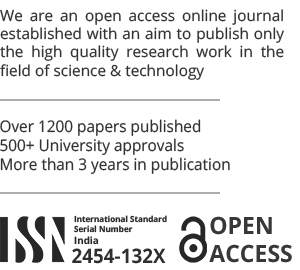IOT Based Water Management System for Smart City
Published by: Patawala Amatulla Hakimuddin, Bansode Navanath Pandurang, Bhong Yogesh .P, Zadbuke Ashwini .S
Full DetailsAutomated Performance Evaluation System
Published by: Sana Akhai, Ruchi Karia, Aniket Mahadik, Akshat Shah, Manya Gidwani
Full DetailsEffect of Microwave (Mw) Treatments of Resistant and Native Starches
Published by: Asha Kumari
Full DetailsA Review on Improve Energy Efficiency in Cognitive Radio Ad Hoc Networks by Selecting Secondary User
Published by: Raghunath K. Borkar, Prof. Sheshnarayan Ghungrad
Full Details
Research Paper
Power System Loss Minimization Using Flower Pollination Algorithm(FPA)-A Comparative Study
Published by: Amandeep, Shavet Sharma, Akshay Rana
Full Details
